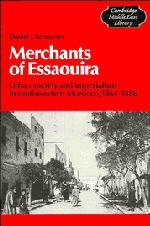Book contents
- Frontmatter
- Contents
- List of illustrations
- Map 1 General map of Morocco
- Preface
- Notes on usage
- Abbreviations
- Chronology
- 1 Introduction
- 2 The royal port
- 3 Merchants of the Sultan
- 4 Port and bazaar
- 5 Beyond the walls
- 6 The politics of trade
- 7 Foreign intervention and domestic reforms
- 8 The struggle for the southwest
- 9 The people of Essaouira in precolonial times
- 10 The end of an era
- Appendix A Corcos collection: nineteenth-century Arabic documents (1843–83)
- Appendix B Population estimates of Essaouira
- Appendix C Balancing revenue and expenditure: accounts of the port
- Appendix D Trade statistics for Essaouira
- Notes
- Bibliography
- Index
6 - The politics of trade
Published online by Cambridge University Press: 04 August 2010
- Frontmatter
- Contents
- List of illustrations
- Map 1 General map of Morocco
- Preface
- Notes on usage
- Abbreviations
- Chronology
- 1 Introduction
- 2 The royal port
- 3 Merchants of the Sultan
- 4 Port and bazaar
- 5 Beyond the walls
- 6 The politics of trade
- 7 Foreign intervention and domestic reforms
- 8 The struggle for the southwest
- 9 The people of Essaouira in precolonial times
- 10 The end of an era
- Appendix A Corcos collection: nineteenth-century Arabic documents (1843–83)
- Appendix B Population estimates of Essaouira
- Appendix C Balancing revenue and expenditure: accounts of the port
- Appendix D Trade statistics for Essaouira
- Notes
- Bibliography
- Index
Summary
The bombardment of Essaouira in 1844 by the French fleet was a decisive turning-point in the history of Essaouira. The pattern of trade that had evolved gradually over the previous twenty years was threatened. Morocco had timidly initiated an opening with Europe by developing a system of royal trade over which the Sultan was able to exercise close control. Such protectionism was to crumble under the weight of foreign pressure. The capacity of Europe to impose its will was demonstrated by the events of 1844. Within a period of fifteen years after the French attack, Morocco had embarked on a precipitous course towards foreign domination. Two decisive events made this inevitable: the treaty with Great Britain in 1856, and the Spanish invasion of Tetuan in 1859–60. Both of them permanently altered the relationship between the Muslim authorities and the foreigners and their protégés in Essaouira.
The revival of trade
The opening of Morocco to Europe began two decades before the war of 1844. Foreign trade was resumed by Sultan ʿAbd ar-Rahmān (1822–59), who had spent some time in Essaouira as governor prior to his succession to the throne. His interest in foreign trade was probably reinforced by his close ties to some of the merchants of the town. In contrast to the reign of Mawlāy Sulaymān, ʿAbd ar-Rahmān viewed trade with Europe as a valuable source of revenue.
- Type
- Chapter
- Information
- Merchants of EssaouiraUrban Society and Imperialism in Southwestern Morocco, 1844–1886, pp. 117 - 131Publisher: Cambridge University PressPrint publication year: 1988



